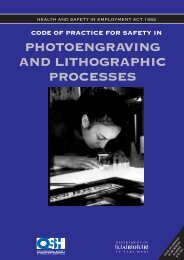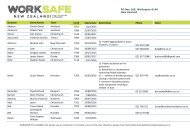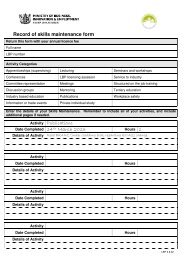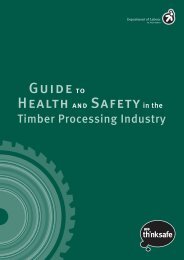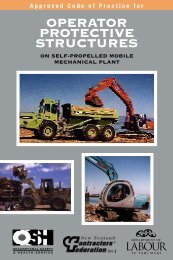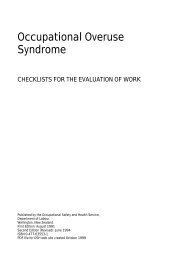Powder-Actuated Hand-Held Fastening Tools ... - Business.govt.nz
Powder-Actuated Hand-Held Fastening Tools ... - Business.govt.nz
Powder-Actuated Hand-Held Fastening Tools ... - Business.govt.nz
You also want an ePaper? Increase the reach of your titles
YUMPU automatically turns print PDFs into web optimized ePapers that Google loves.
HEALTH AND SAFETY IN EMPLOYMENT ACT 1992APPROVED CODE OF PRACTICE FORPOWDER-ACTUATED,HAND-HELDFASTENING TOOLSOCCUPATIONAL SAFETY& HEALTH SERVICEDEPARTMENT OFLABOURTE TARI MAHIISSUED AND APPROVEDBY THE MINISTEROF LABOURMAY 1995
Published by the Occupational Safety and Health ServiceDepartment of LabourWellingtonNew ZealandMay 1995ISBN 0-477-03571-X$10 (incl. GST)
CONTENTSNOTICE OF ISSUE ......................................................... 5FOREWORD................................................................... 6A SUMMARY OF THE HEALTH AND SAFETY INEMPLOYMENT ACT 1992 .............................................. 7Regulations 7Approved Codes of Practice 7Employers’ duties 7Hazard management 8Information for employees 8Employers to Involve employees in the development of health and safetyprocedures 9Training of employees 9Safety of people who are not employees 9Employees and self-employed persons’ duties 9Accidents and serious harm (records and notification) 9SECTION 1: SCOPE AND GENERAL ............................ 111.1 Introduction 111.2 Scope 111.3 Definitions 111.4 Documentation 131.5 Ancillary equipment 131.6 Responsibilities 131.7 Instruction and training 141.8 Certificated operators 151.9 Certificate of competence as powder-actuated tool operator 151.10 Examination for certificate 151.11 Issue of Certificates of Competency 151.12 Expiry and Renewal 16SECTION 2: SELECTION OF TOOLS AND SAFETYPRECAUTIONS ............................................................ 172.1 Operation of powder-actuated fastening tools 172.2 General 172.3 <strong>Powder</strong>-<strong>Actuated</strong> fastening tool loading 172.4 Personal protective equipment 182.5 Using the powder-actuated fastening tool 18
2.6 Fasteners and charges 182.7 Firing through existing holes 192.8 Working environment 192.9 Material characteristics 192.10 Unsuitable materials 202.11 Use of caution signs 212.12 Misfiring 212.13 Storage of powder-actuated fastening tools and charges 22SECTION 3: INSPECTION AND MAINTENANCE .......... 233.1 Inspection 233.2 Maintenance 233.3 Repairs 23REFERENCED DOCUMENTS ...................................... 244 POWER-ACTUATED, HAND-HELD FASTENING TOOLS
NOTICE OF ISSUEI have issued this Approved Code of Practice for <strong>Powder</strong>-<strong>Actuated</strong>, <strong>Hand</strong>-<strong>Held</strong><strong>Fastening</strong> <strong>Tools</strong>, being a statement of preferred work practices or arrangementsfor the purpose of ensuring the health and safety of persons to which thiscode applies and persons who may be affected by the activities covered bythis code.J. M. ChetwinSecretary of LabourMay 1995POWER-ACTUATED, HAND-HELD FASTENING TOOLS 5
FOREWORDI have approved this statement of preferred work practices, which is an ApprovedCode of Practice for <strong>Powder</strong>-<strong>Actuated</strong>, <strong>Hand</strong>-<strong>Held</strong> <strong>Fastening</strong> <strong>Tools</strong>, under section20 of the Health and Safety in Employment Act 1992. When a code is approved, aCourt may have regard to it in relation to compliance with the relevant sections ofthe Health and Safety in Employment Act. This means that if an employer in anindustry or using a process to which an approved code applies can showcompliance with that code in all matters it covers, a Court may consider this to becompliance with the provisions of the Act to which the code relates.Hon. Doug KiddMinister of LabourMay 19956 POWER-ACTUATED, HAND-HELD FASTENING TOOLS
A SUMMARY OF THE HEALTHAND SAFETY IN EMPLOYMENTACT 1992The principal object of the Health and Safety in Employment Act 1992 (HSE Act)is to prevent harm to employees at work. To do this, it imposes duties onemployers, employees, principals and others, and promotes excellent health andsafety management by employers. It also provides for the making of regulationsand codes of practice.REGULATIONSRegulations are promulgated from time to time under the HSE Act. Regulationsmay impose duties on employers, employees, designers, manufacturers, andothers relating to health and safety. These regulations may apply with respect toplaces of work, plant, processes or substances and may have been made to dealwith particular problems that have arisen.APPROVED CODES OF PRACTICE“Approved Codes of Practice” are provided for in the HSE Act. They arestatements of preferred work practice or arrangements, and may includeprocedures which could be taken into account when deciding on the practicablesteps to be taken. Compliance with codes of practice is not mandatory.However, it may be used as evidence of good practice in Court.EMPLOYERS’ DUTIESEmployers have the most duties to perform to ensure the health and safety ofemployees.Employers have a general duty to take all practicable steps to ensure the safety ofemployees at work. In particular, they are required to take all practicable stepsto:(a)(b)(c)(d)(e)Provide and maintain a safe working environment;Provide and maintain facilities for the safety and health of employees atwork;Ensure that machinery and equipment is safe for employees;Ensure that working arrangements are not hazardous to employees; andProvide procedures to deal with emergencies that may arise whileemployees are at work.POWER-ACTUATED, HAND-HELD FASTENING TOOLS 7
Taking “all practicable steps” means doing what is reasonably able to be done inthe circumstances; taking into account:(a)(b)(c)(d)The severity of any injury or harm to health that may occur;The degree of risk or probability of that injury or harm occurring;How much is known about the hazard and the ways of eliminating,reducing or controlling it; andThe availability, effectiveness and cost of the possible safeguards.HAZARD MANAGEMENTEmployers must identify and regularly review hazards in the place of work(existing, new and potential), to determine whether they are significant hazardsand require further action. If an accident or harm occurs that requires particularsto be recorded, employers are required to investigate it to determine if it wascaused by or arose from a significant hazard.“Significant hazard” means a hazard that is an actual or potential cause or sourceof:(a)(b)Serious harm; orHarm (being more than trivial) where the severity of effects on any persondepends (entirely or among other things) on the extent or frequency ofthe person’s exposure to the hazard; or(c) Harm that does not usually occur, or usually is not easily detectable, untila significant time after exposure to the hazard.Where the hazard is significant, the HSE Act sets out the steps employers musttake:(a)(b)Where practicable, the hazard must be eliminated.If elimination is not practicable, the hazard must be isolated.(c) If it is impracticable to eliminate or isolate the hazard completely, thenemployers must minimise the hazard to employees.Where the hazard has not been eliminated or isolated, employers must, whereappropriate:(a)(b)(c)(d)Ensure that protective clothing and equipment is provided, accessible andused;Monitor employees’ exposure to the hazard;Seek the consent of employees to monitor their health; andWith informed consent, monitor employees’ health.INFORMATION FOR EMPLOYEESBefore employees begin work, they must be informed by their employer of:(a)(b)Hazards employees may be exposed to while at work;Hazards employees may create which could harm other people;8 POWER-ACTUATED, HAND-HELD FASTENING TOOLS
(c)(d)How to minimise the likelihood of these hazards becoming a source ofharm to themselves and others;The location of safety equipment; and(e) Emergency procedures.Employers are also to required to inform employees of the results of any healthand safety monitoring. In doing so, the privacy of individual employees must beprotected.EMPLOYERS TO INVOLVE EMPLOYEES IN THEDEVELOPMENT OF HEALTH AND SAFETY PROCEDURESEmployers need to ensure that all employees have the opportunity to be fullyinvolved in the development of procedures for the purpose of identifying hazardsand dealing with significant hazards or dealing with or reacting to emergenciesand imminent dangers.TRAINING OF EMPLOYEESEmployers must ensure employees are either sufficiently experienced to do theirwork safely or are supervised by an experienced person. In addition, employeesmust be adequately trained in the safe use of equipment in the place of work,including protective clothing and equipment.SAFETY OF PEOPLE WHO ARE NOT EMPLOYEESEmployers are also responsible for the health and safety of people who are notemployees. Employers must take all practicable steps to ensure that employeesdo not harm any other person while at work, including members of the public orvisitors to the place of work.EMPLOYEES AND SELF-EMPLOYED PERSONS’ DUTIESEmployees and self-employed persons are responsible for their own safety andhealth while at work. They must also ensure that their actions do not harmanyone else. However, these responsibilities do not detract from the employer’sor principal’s responsibilities.ACCIDENTS AND SERIOUS HARM (RECORDS ANDNOTIFICATION)The HSE Act requires employers to keep a register of work-related accidents andserious harm. This includes every accident that harmed (or might have harmed):(a)(b)Any employee at work;Any person in a place of work under the employer’s control.POWER-ACTUATED, HAND-HELD FASTENING TOOLS 9
Employers are also required to investigate all accidents, harm and near-misses todetermine whether they were caused by a significant hazard.Employers are required to notify serious harm that occurs to employees while atwork to the Secretary of Labour (in practice, the nearest OSH office), as soon aspossible. In addition, the accident must also be reported on the prescribed formwithin 7 days. (Forms are included in the Workplace Accident Register availablefrom OSH offices and selected stationers.)If a person suffers serious harm, the scene of the accident must not be disturbedunless to:(a)(b)Save life or prevent suffering;Maintain public access for essential services, e.g. electricity, gas;(c) Prevent serious damage or loss of property.The OSH office will advise whether it wishes to investigate the accident and whataction may be taken in the meantime.10 POWER-ACTUATED, HAND-HELD FASTENING TOOLS
SECTION 1: SCOPE ANDGENERAL1.1 INTRODUCTIONThis code of practice has been published to assist in realising the aim of betterprovision for safety by providing recommendations and procedures for the safeuse and maintenance of powder-actuated fastening tools.It is recommended for all employees who have to use a powder-actuated tool inthe course of their work.In this code “Act” means the Health and Safety in Employment Act 1992 and“Regulations” means the Health and Safety Regulations 1995.1.2 SCOPEAll places of work at which an employee has to use a powder-actuated tool in thecourse of their duties.1.3 DEFINITIONS1.3.1 SHIELDA device attached to the muzzle end of the tool, designed to prevent the escapeof the fastener and flying particles or material that could ricochet.1.3.2 AUTHORISED GUNSMITHIn relation to powder-actuated fastening tools, means a person certified in writingby the master agent in New Zealand, or the maker of the tool, as competent tocarry out repairs and overhauls to named models of the tool.1.3.3 CERTIFICATED OPERATORSPersons who have successfully passed a qualifying competency test acceptable tothe Secretary of Labour. Persons who exhibit colour blindness shall demonstratethat they can identify different charges.POWER-ACTUATED, HAND-HELD FASTENING TOOLS 11
1.3.4 CHARGEA cased cartridge or a caseless pellet of explosive, designed specifically for apowder-actuated, hand-held fastening tool.1.3.5 CONSTRUCTION WORKAny work in connection with the construction, erection, installation, repair,maintenance, cleaning, painting, renewal, removal, alteration, dismantling ordemolition of any building, structure, bridge or any other engineering work,including scaffolding, excavation, site preparation, use of explosives and use ofmechanical plant. It also includes any such work carried out underwater,including work on ships, wrecks, buoys, rafts, and obstructions to navigation; aswell as any inspection or other work carried out for the purpose of ascertainingwhether construction work should be carried out.1.3.6 DIRECT-ACTING TOOLA tool in which the driving force is directly applied to the fastener.1.3.7 INDIRECT-ACTING TOOLA tool in which the driving force is transmitted to the fastener by means of apiston with limited axial movement.1.3.8 POWDER-ACTUATED FASTENING TOOLA powder-actuated fastening tool is defined as a hand tool capable of driving apin, stud, bolt, or similar object, into or through building materials, by means ofan explosive force derived from the detonation of a cartridge containing anexplosive; and includes every accessory or device that may be used with the tool.1.3.9 EMPLOYEE OR SELF-EMPLOYED PERSONMeans person employed by any other person to do any work (other thanresidential work) for hire or reward; and in relation to any employer, means anemployee of the employer.1.3.10 EMPLOYERA person who or that employs any other person to do any work for hire orreward, and, in relation to any employee, means an employer of the employee.1.3.11 FASTENERA special-purpose fastener stud, pin, nail, dowel, rivet or similar object designedto be driven into, or through, any substance by a powder-actuated fastening tool.12 POWER-ACTUATED, HAND-HELD FASTENING TOOLS
1.4 DOCUMENTATIONEvery tool should be provided with operating instructions for the safe use,handling and maintenance of the tool and its accessories. These instructionsshould include at least the following:(a)(b)(c)(d)(e)(f)An illustration of the tool showing the basic operating function and parts.A list of components which an certificated operator is permitted tochange.A list of the various fasteners and charges which are nominated to be usedin the tool.NOTE: These fasteners should comply with AS/NZS 1873.4:1994.A listing of charges and colours of charges recommended for use in thetool. This description should comply with AS/NZS 1873.3:1994.Procedures to be followed in the event of a misfire.Maintenance instructions.1.5 ANCILLARY EQUIPMENTEvery tool should be accompanied by a lockable rigid equipment container orcase with compartments to accommodate the fastening tool and any otherattachments, equipment, or other materials recommended by the manufacturer orthe manufacturer’s New Zealand master agent for the safe operation andmaintenance of the tool.(a)(b)A sign should be affixed to the inside face of the container highlightingthe need for CAUTION signs to be displayed and the need for operatorsto wear eye and ear protectors when using fastening tools.A separate compartment should be provided within the container for thestoring of charges. Such a compartment should:(i) be clearly labelled with the word CHARGES; and(ii) if removable from the container, be lockable.1.6 RESPONSIBILITIESOnly powder-actuated fastening tools that have been designed and manufacturedin accordance with AS/NZS 1873.2:1994 <strong>Powder</strong>-actuated hand-held fasteningtools, fasteners and explosive charges, or its equivalent, may be used.Any person leasing or hiring out a powder-actuated tool has a duty to draw theattention of the hirer to the fact that the tool may be used on a place of work onlyby a certificated operator. Hire tools should have a suitable notice to this effectattached to the inside of the lid of the case or container.Employers must ensure that:(a)<strong>Powder</strong>-actuated fastening tools are operated by certificated operators andused in accordance with the operating instructions and this code; andPOWER-ACTUATED, HAND-HELD FASTENING TOOLS 13
(b) <strong>Tools</strong> are inspected regularly, repaired and maintained by thosecompetent to carry out the work.Operators must use the tool safely and in accordance with the operatinginstructions and this code.1.7 INSTRUCTION AND TRAINING1.7.1 REQUIREMENTSThe master agent or representative of every make of powder-actuated fasteningtools shall provide an approved course of instruction in the use, care andmaintenance of the make of tool as set out below.1.7.2 INSTRUCTIONInstruction shall cover the care, use, and maintenance of the tool and shall begiven by a competent person trained and nominated by the master agent for thetool. The instruction shall include the following:(a)(b)(c)(d)(e)(f)(g)(h)Principles of operating and knowledge of its construction;Preparing and checking the tool before use;Selection of the correct cartridge, pin, and guard or shield, taking intoaccount the type of material being fired into and the distance from theedge;Loading and firing procedures and safety precautions;Misfire procedure;Limitations of use of the tool and its accessories;Eye and ear hazards and hazards in explosive atmospheres;Basic servicing and testing the tool.1.7.3 TRAININGIn addition to instruction, a person who has not previously had proper experiencein the use of the tool shall undergo a period of suitable training. This trainingshall be on regular work and under the direct personal supervision of anexperienced certificated operator.This training period must include practical training to enable the trainee to obtainexperience under various working conditions and with different kinds of buildingmaterials. Part of the training may be taken before the instruction. The practicaltraining would normally follow after the course of instruction and terminate with apractical demonstration and test to the satisfaction of the person nominated forthis purpose by the master agent.14 POWER-ACTUATED, HAND-HELD FASTENING TOOLS
1.8 CERTIFICATED OPERATORSA powder-actuated fastening tool being used in a place of work shall not beloaded or fired except by a person who is the holder of a certificate ofcompetency issued by the manufacturer or their master agent as a powderactuatedtool operator relating to the make of the tool being used.Provided that a person training for any such certificate may operate any such toolunder the direct personal supervision of the holder of an appropriate certificate.1.9 CERTIFICATE OF COMPETENCE AS POWDER-ACTUATED TOOL OPERATORAn applicant for a certificate of competence as a powder-actuated fastening toolsoperator, before being granted a certificate, shall provide evidence that theapplicant has suitable training in the operation of powder-actuated fastening toolsand a thorough knowledge of the safe practices relating to that operation.Applicants for a certificate as a powder-actuated fastening tool operator, beforebeing granted a certificate, shall comply with the following requirements:(a)(b)They shall produce evidence to the examiners that they have receivedinstruction and training in the use, care and maintenance of the tool towhich the application relates.They shall satisfy the examiners that they are not suffering from any defectof colour vision which would render them unfit to select cartridges of theright strength.(c) They shall satisfy the examiners, in oral examination, that they havecomplied with the provisions of the HSE Regulations relating to thegranting of the certificate.Every application shall relate to such makes of tools as the applicant may specifyand each certificate as a powder-actuated tool operator granted in accordancewith the HSE Regulations shall relate only to such makes of tools as may beprescribed in the certificate.A certificate as a powder-actuated fastening tool operator under the regulationsmay be restricted in its application to such special trades or kinds of work as maybe prescribed in the certificate.1.10 EXAMINATION FOR CERTIFICATEThe subject-matter for the oral examination shall include hazards in the use ofpowder-actuated fastening tools and the special precautions to be taken byoperators thereof, as set out in an approved code of safe practices relating to theuse of powder-actuated fastening tools.1.11 ISSUE OF CERTIFICATES OF COMPETENCYThe Secretary of Labour has recognised manufacturers of powder-actuatedfastening tools and their New Zealand master agents as being competent toconduct examinations and issue the appropriate class of certificate.POWER-ACTUATED, HAND-HELD FASTENING TOOLS 15
1.12 EXPIRY AND RENEWALA certificate as a powder-actuated fastening tools operator remains in forcewithout the need for renewal for such periods as may be prescribed by theSecretary of Labour.16 POWER-ACTUATED, HAND-HELD FASTENING TOOLS
SECTION 2: SELECTION OFTOOLS AND SAFETYPRECAUTIONS2.1 OPERATION OF POWDER-ACTUATED FASTENINGTOOLS(a)(b)(c)(d)Every employer shall take all practicable steps to ensure that everyemployee who operates a powder-actuated fastening tool in the course ofthat employee’s work is the holder of a certificate of competence as apowder-actuated fastening tool operator granted in accordance with theHSE Regulations.Every self-employed person who operates a powder-actuated fasteningtool in the course of that person’s work shall be the holder of a certificateof competence as a powder-actuated fastening tool operator granted inaccordance with the HSE Regulations.Every owner of a powder-actuated fastening tool shall take all practicablesteps to ensure that every person who operates that tool in the course ofthat person’s work is the holder of a certificate of competence as apowder-actuated fastening tools operator, granted in accordance with theHSE Regulations, which is appropriate to that type of tool.Nothing in this regulation shall prevent a person in training to become theholder of a certificate of competence from operating a powder-actuatedfastening tool under the direct supervision of the holder of an appropriatecertificate.2.2 GENERALWhen using a powder-actuated fastening tool, operators have a responsibility toprotect themselves and others from hazards associated with this type of work.These hazards can and should be managed. The operator of a powder-actuatedfastening tool should manage the hazards through compliance with this code inconjunction with any manufacturer’s requirements.2.3 POWDER-ACTUATED FASTENING TOOL LOADINGThe operator should comply with the following requirements regarding loading ofa powder-actuated fastening tool with a charge and fastener:POWER-ACTUATED, HAND-HELD FASTENING TOOLS 17
(a)(b)(c)Only load the powder-actuated fastening tool at the place where it isintended to be used and immediately prior to its use.Only carry a loaded powder-actuated fastening tool when, because ofmechanical failure, it cannot be unloaded.If the powder-actuated fastening tool has been loaded but not put intoimmediate operation, remove both the charge and fastener.2.4 PERSONAL PROTECTIVE EQUIPMENTDuring firing of the powder-actuated fastening tool, operators should ensure thatall persons required to be in the immediate vicinity of the firing activities, wear:(a)Suitable eye protectors complying with AS/NZS 1337; and(b) Suitable ear protectors complying with AS 1270.2.5 USING THE POWDER-ACTUATED FASTENING TOOLWhen using a powder-actuated fastening tool, the operator should comply withthe following:(a)(b)(c)(d)(e)(f)Ensure the barrel of a loaded or unloaded powder-actuated fastening toolis always pointed in a safe direction away from the operator’s body and isat no time pointed towards any person. This applies in particular where acharge that has misfired is being removed.Only certificated operators, and where necessary their assistants or othernominated persons, should be permitted in the immediate vicinity of thefiring place. Other persons should be kept out of the immediate vicinityof the firing place. <strong>Powder</strong>-actuated fastening tools should not beoperated in areas congested with people.Operators should ensure they are in a safe and well-balanced positionbefore firing.Always use the weakest charge when firing for the first time intopreviously untried material.When there is a possibility that a fastener may pass completely throughthe material, the area on the opposite side to the operating locationshould be kept clear of persons in all directions for a distance which willensure that injury from the fastener or associated debris cannot occur.The area on the opposite side to the operating location should becordoned to restrict entry with appropriate CAUTION signs beingdisplayed (see 2.11).In the event of a misfire, ensure the correct procedure is followed (see2.12).2.6 FASTENERS AND CHARGESThe operator should comply with the following requirements regarding the choiceof fasteners and charges for a particular powder-actuated fastening tool:18 POWER-ACTUATED, HAND-HELD FASTENING TOOLS
(a) Ensure that only those fasteners and charges complying with NZS 1873.3and NZS 1873.4 are used in the tool. These items must be clearly markedand packaged to show the name and model of tool for which the chargeor pin is nominated as being suitable.(b)Ensure that fasteners and their attachments are not modified aftermanufacture, particularly if modified to achieve interchangeabilitybetween types and makes of powder-actuated fastening tools.2.7 FIRING THROUGH EXISTING HOLESThe operator should ensure that direct acting powder-actuated fastening tools arenot used to drive fasteners through fixtures which have existing holes(misalignment can lead to ricochets) unless the tool is specifically equipped by themanufacturer to do so. Indirect-acting, powder-actuated fastening tools may beused in this way provided the point of the fastener can be firmly located in thehole in the fixture prior to firing.2.8 WORKING ENVIRONMENTThe operator should be satisfied that the immediate working environment doesnot pose a hazard when that operator fires the powder-actuated fastening tool.The operator should ensure that the following do not present a hazard:(a)(b)(c)(d)Particles on work surfaces which may fly off during fastening. Worksurfaces should be clear of such material.Concealed pipes or electrical wiring. Check the location of pipes orelectrical wiring to ensure that they are not concealed within the materialat the point of firing.The presence of any explosive or flammable gas, dust or vapour, or anatmosphere which is compressed. Do not use a powder-actuatedfastening tool in these circumstances.The presence of excessive heat, which may cause the charge to beunintentionally exploded. Do not use a powder-actuated fastening tool inthese circumstances.2.9 MATERIAL CHARACTERISTICSWhen fixing materials together with powder-actuated fastening tools, use onlymaterials which are suitable for this fixing method. When firing into materials witha powder-actuated fastening tool, the operator should comply with the following:(a)Where a concrete structure is of a prestressed or post-tensioned type,advice should be sought from its designer or other suitably qualified party,regarding the suitability and placement of fasteners to be set into thesestructures.NOTE: Fasteners set too close to the prestressing wires or cables maydamage these elements and could compromise the integrity of thestructure.POWER-ACTUATED, HAND-HELD FASTENING TOOLS 19
(b)(c)Due to the risk of disintegration of the materials, fasteners should not bedriven into concrete, or similar material, under the followingcircumstances:(i) Nearer than 75 mm to an edge;(ii) Nearer than 75 mm to another fastening;(iii) Where the thickness of the material is less than 100 mm, or less than3 times the shank penetration into the base material, whichever is thelesser; or(vi) Nearer than 150 mm to where another fastener has failed to fullypenetrate and has damaged the surrounding base material (spalling).Where fixings are made into steel with a higher strength than commongrades of structural steel (i.e. above grade 350), advice should be soughtto ensure the correct selection of powder-actuated fastening tools,fasteners and charges.Fasteners should not be driven into steel under the following circumstances:(i) Nearer than 16 mm to an edge;(ii) Nearer than 25 mm to another fastener;(iii) Nearer than 100 mm to a heat-affected zone (see 2.10 (ii));(vi) Less than 4 mm in thickness or 3 mm in thickness when specialisedfasteners are intended to be used.2.10 UNSUITABLE MATERIALSSome materials are considered to be unsuitable to be fixed together usingpowder-actuated fastening tool. These may be:(a)(b)The base material (for example, concrete and steel); andThe material to be fixed to that base material (for example timber orsteel);(c) Spalled areas caused by previous unsatisfactory fastening.When firing into particular materials with a powder-actuated fastening tool, theoperator should comply with the following:(a)(b)(c)(d)Do not drive fasteners into brittle materials which are liable to shatter andmaterials which are too hard. Unsuitable brittle materials include castiron, marble, glazed tiles, slate, natural stones, fired clay bricks. Concreteand concrete products with a compressive strength greater than 60 MPAare also unsuitable as they are too hard.Do not drive fasteners into areas of steel that have been affected bywelding, flame cutting or similar processes.Do not drive fasteners into joints in masonry, for example brickwork orstonework joints.Do not drive fasteners into timber where timber is the base material. Atimber member is unsuitable for the purpose of securing another timbermember to it. Manufactured products such as plywood, hardboard and20 POWER-ACTUATED, HAND-HELD FASTENING TOOLS
(e)particle board are considered to be timber where those products havesimilar physical characteristics to timber.Do not drive fasteners into soft materials with a low compressive strength(i.e. concrete of less than 10 MPA) as they are unsuitable for use as a basematerial. Unsuitable materials include plaster board and lightweight,aerated or weak concrete.NOTE: As a general rule, do not fire into any material which dulls the point ofa fastener if used as a centre punch as this material is too hard for thefastener to penetrate.2.11 USE OF CAUTION SIGNSAt all times when a powder-actuated tool is being used, a notice or noticesbearing the following words CAUTION: EXPLOSIVE-POWERED TOOL IN USEshould be displayed so as to be clearly legible to all persons who are in, or near,the place where the tool is being used.This notice or notices should:(a)(b)(c)(d)Be displayed on rigid rectangular board, measuring not less than 500 mmin width and 300 mm in height;Incorporate lettering not less than 50 mm high for the word CAUTIONand not less than 30 mm high for the remainder of the text;Comply with the relevant requirements of NZS/AS 1319:1983; andIf bearing the logo of the site owner or contractor, ensure that such nameor logo does not reduce the legibility of the message and does not exceed20 mm in height.2.12 MISFIRINGThe operator should comply with the following requirements when a powderactuatedfastening tool misfires:(a)(b)(c)In the event of a misfire, observe the manufacturer’s misfire precautionsand procedures. In the event of a misfire, where the manufacturer hasnot provided specific instructions, the operator should comply with thefollowing:(i) First wait 10 seconds, then release the powder-actuated fastening toolfrom its depressed condition.(ii) Second, release the powder-actuated fastening tool from the worksurface without changing the direction in which the tool is pointing.(iii) Finally, remove the charge and store it safely for later disposal.Any charges which have misfired should not be used again. Rather theyshould be returned to the supplier for destruction.If numerous misfires occur from one batch of charges, that batch shouldbe returned to the supplier for destruction.POWER-ACTUATED, HAND-HELD FASTENING TOOLS 21
2.13 STORAGE OF POWDER-ACTUATED FASTENINGTOOLS AND CHARGESWhen not in use, persons in control of the powder-actuated fastening tool andcharges should comply with the following requirements:(a)(b)Before and after using the powder-actuated fastening tool, the operatorshould ensure:(i) The tool is cleaned;(ii) The charges and unloaded powder-actuated fastening tool are in theirbox or case; and(iii) The case or container is locked.Persons in control of the powder-actuated fastening tool and charges,when not in use, should ensure the equipment is stored in a secure place.Persons in control of the powder-actuated fastening tool and charges maybe the site manager, the employer, the operator or the owner.22 POWER-ACTUATED, HAND-HELD FASTENING TOOLS
SECTION 3: INSPECTION ANDMAINTENANCE3.1 INSPECTIONA powder-actuated fastening tool should be inspected in accordance with themanufacturer’s instructions immediately prior to use on any particular day toensure it is fully operational and is free from any defect that has been revealed byany inspection, examination or overhaul.3.2 MAINTENANCEThe user of the powder-actuated fastening tool should ensure that themanufacturer’s maintenance instructions are observed to ensure each tool is keptin good working order and to ensure it functions correctly.Every powder-actuated fastening tool should:(a)(b)Be cleaned at least once a day after use; andAt least once in every week in which the tool is used, dismantled andexamined for defects by a certificated operator.3.3 REPAIRS<strong>Powder</strong>-actuated fastening tools should be serviced only by suitably qualifiedpersons recognised by the manufacturer or the master agent.Operators of powder-actuated fastening tools should only carry out simplereplacement of worn parts which are specifically listed in manufacturer’s“instructions for use”. Repair work should only be carried out by personsnominated by the manufacturer.After any overhaul, the person who carried out the overhaul should ensure acertificate is issued stating that the tool is free from defects. (This certificateshould be displayed inside the lid of the case or container.)<strong>Powder</strong>-actuated fastening tools should be returned to the manufacturer’s masteragent for a complete overhaul every 6 months.POWER-ACTUATED, HAND-HELD FASTENING TOOLS 23
REFERENCED DOCUMENTS(1) Health and Safety in Employment Act 1992.(2) Health and Safety in Employment Regulations 1995.(3) AS 1270:1988 Hearing protection devices.(4) NZ/AS 1319:1983 Safety signs for the occupational environment.(5) AS/NZS 1337:1992 Eye protectors for industrial applications.(6) AS/NZS 1873:1994 Parts 1-4 <strong>Powder</strong>-actuated hand-held fastening tools,fasteners and explosive charges.24 POWER-ACTUATED, HAND-HELD FASTENING TOOLS


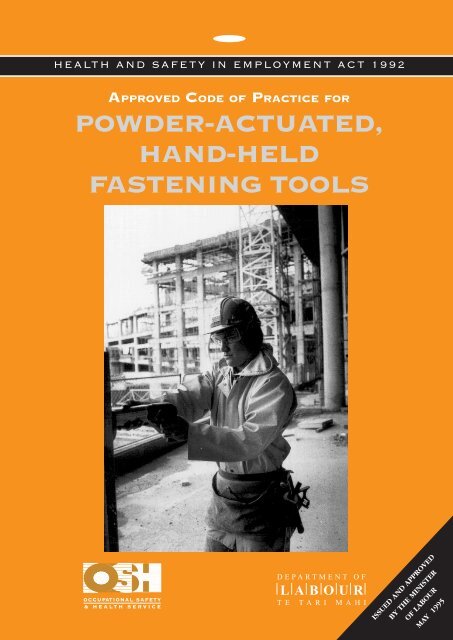

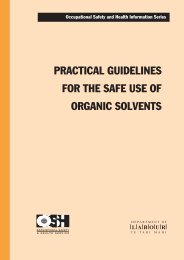
![Task analysis worksheet [161 KB PDF] - Business.govt.nz](https://img.yumpu.com/51400981/1/190x135/task-analysis-worksheet-161-kb-pdf-businessgovtnz.jpg?quality=85)

